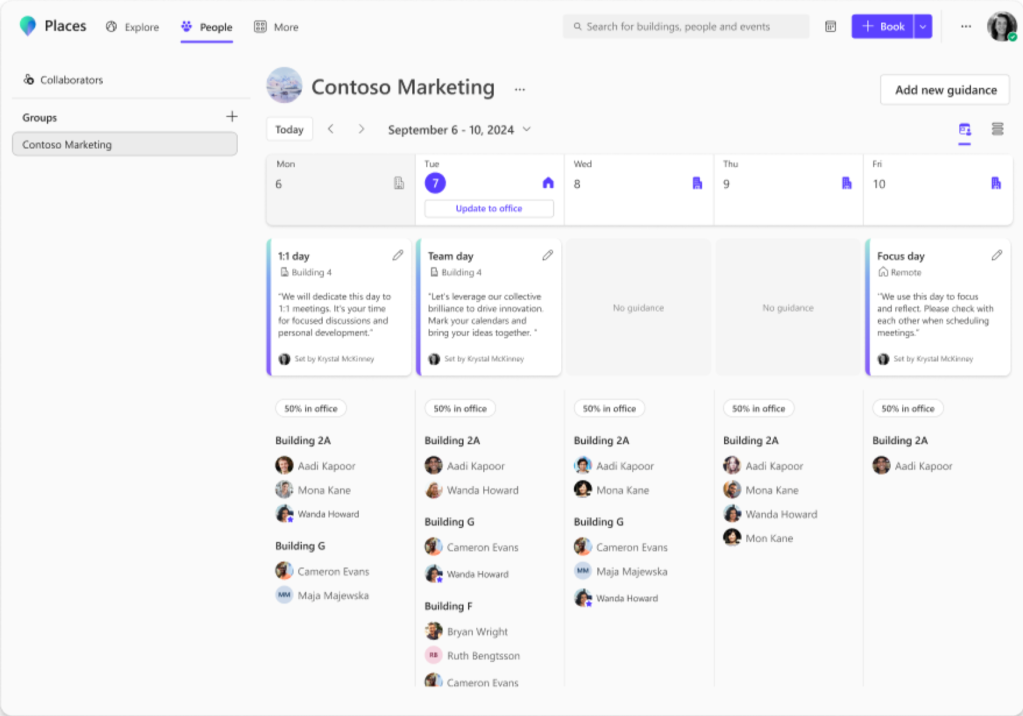As hybrid work arrangements become more common, it can be a challenge to get coworkers in the same place at the same time. With that in mind, Microsoft hopes to make it easier to coordinate in-person collaboration with the launch of Places, an app with features to help plan the time employees spend in the office.
“Microsoft Places seems well-suited to help organizations address the challenges involved in supporting a hybrid workplace,” said Raúl Castañón, senior research analyst at 451 Research, part of S&P Global Market Intelligence. The transition to a hybrid work model has involved more than a reduction in office footprint, he said, resulting in a shift of the physical office to a “collaborative, flexible space,” with fluctuating occupancy.
With Places, workers can set their own proposed location schedule and display it for others to see. The information can be set using the Places app itself or in Outlook Calendar. They can to also view the schedules for colleagues and managers, while managers can specifycertain days when staffers are expected to be in the office.
Microsoft plans to integrate Places data with its Copilot generative AI (genAI) assistant later this year, the company said in a blog post Monday. This will enable suggestions about which days are best for individuals to come into the office, highlighting in-person meetings and the planned presence of managers and coworkers.
A booking feature called “Places find” — also accessible from Outlook — lets users search for available rooms and desks. Here, images of rooms or desk pools are displayed on an office map, with details about available technology and other amenities. Users will receive reminders if they haven’t booked a room on a day they’re scheduled to be in the office. The upcoming Copilot integration will automatically find and book meeting spaces on behalf of users.

Places is designed to make it easier for hybrid workers to connect with colleages when in the office.
Microsoft
The AI features are the most eye-catching element in Places, said Jack Gold, founder and principal analyst at J. Gold Associates.
“The ability to have an assisted intelligence agent ‘uncomplicate’ scheduling and peer connectivity issues will be well received, if it works as planned…,” he said. “Most of us have too many complicated interactions theses days and raising the needed flags for pending obligations is a welcome feature.”
An “expanded presence” feature enabled by Places is available across Microsoft 365 apps. Itprovides users with a glimpse of who’s in the office at the same time, making it easier for coworkers to arrange a quick face-to-face chat. Microsoft said all location data adheres to its privacy standards, with opt-in and opt-out controls accessible to admins and users.
The “expanded presence” data is “aggregated and anonymized in reports about office occupation trends,” Microsoft said in the blog post.
Places will also provide admins and facilities managers with analytics on office use, letting them see what space is available and what’s actually needed. Copilot, once integrated with Places, will provide suggestions on how best to manage and adapt spaces to meet demand.
Adapting to new working patterns is a challenge facing many companies, said Gold. “While the pendulum has begun to swing back to in-office work for some organizations, after a rapid increase in remote work spurred by office closures during the COVID-19 pandemic, the reality for most is that they’ll be supporting some level of hybrid work going forward,” he said. “I don’t expect that to change anytime soon.”
A recent 451 Research report indicated that organizations are investing in various technologies to enable a hybrid workplace, including contactless technologies such as biometrics and voice user interfaces (28%) and office space management technology (35%) that includes hot-desk reservations, IoT sensors and AI-driven analytics to optimize office capacity.
“We expect these trends will continue throughout 2024, as a significant number of surveyed organizations say they will continue to invest in these technologies over the next 12 months,” said Castañón.
Microsoft Places competes with a range of products, including various hybrid work management features available in productivity and collaboration software suites from Zoom and Google. The Places app could make sense for customers that want to remain with Microsoft apps.
“There are a number of tools that offer equivalent capabilities to Places,” said Gold, but the integration of feature into Microsoft 365 makes it “easier for enterprises to focus on staying in the Office environment rather than finding piece-meal approaches, or moving wholesale to a different productivity suite.”
Microsoft Places is available in public preview now for Teams Premium subscribers.

